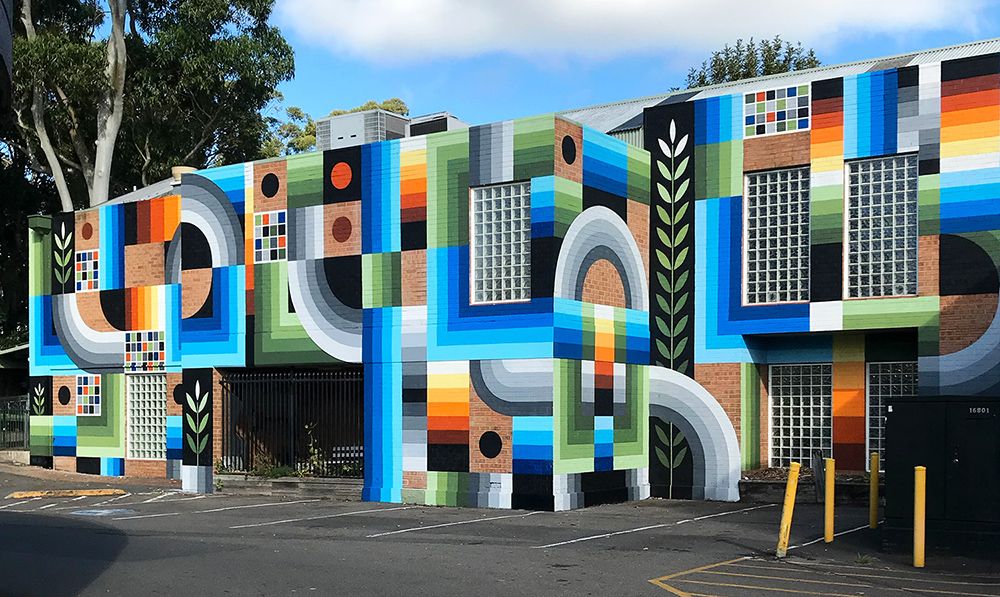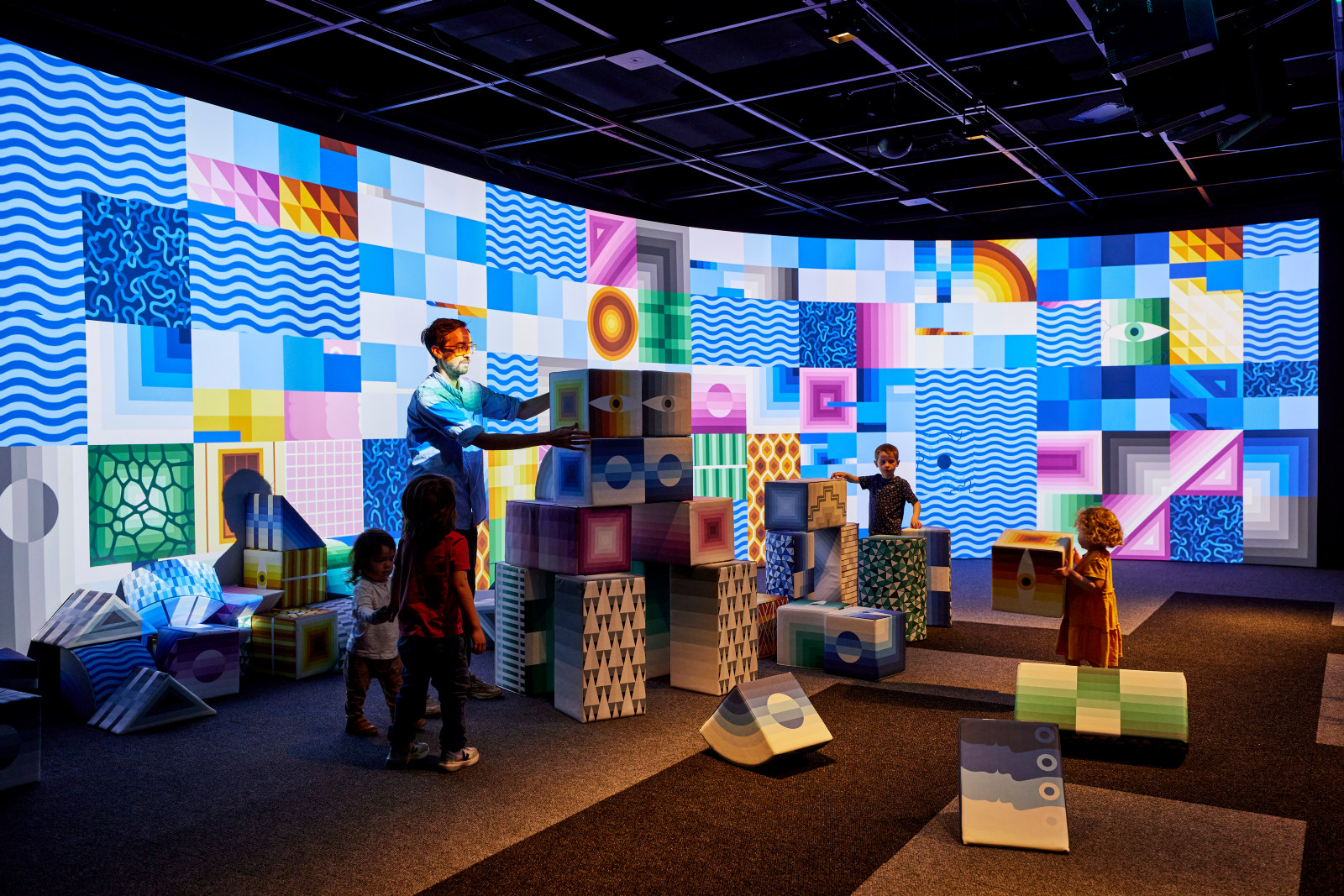Inside the creative mind of Beastman
We spoke to Beastman about his art and how he created the vibrant, abstract patterns for PlayScapes.
Beastman (Bradley Eastman) is the artist, as part of the Junior Major creative team, behind our PlayScapes exhibition – a series of interactive experiences that encourage different forms of play. Inspired by the city and landscapes of Sydney and Museums of History NSW properties, Beastman created colourful, graphic patterns that represent the natural world and built environment distilled to their simplest, still recognisable form. It’s a way of looking at his surroundings and making art that Beastman developed from his interest in skateboarding and desire for a harmonious relationship between humans and nature.
Beastman has been drawing and creating art since he was a child and he studied graphic design after high school. He was also a skateboarder and his interest in skateboarding culture had a strong influence on his art and style.
Skateboarding culture comes with a very creative aesthetic and DIY culture. I was into the branding and visual world that was part of skate culture, and inspired by artists creating graphics for skate brands. It inspired me to be more creative.
His distinctive style has developed and evolved over the course of 25-plus years while staying true to its origins. ‘It started with unique characters filled with pattern, then I realised I was painting or drawing landscapes and creating environments’, Beastman says. In these artworks, the geometric structure provides a framework for free-flowing organic forms to snake and meander around. Together, they represent Beastman’s vision for a positive, collaborative relationship between humans and the natural world.

Much of the artist’s awareness of the built environment around him stems from being a skateboarder and interacting with the man-made world. ‘As a skateboarder, I look differently at the streets, sidewalks and buildings. Stairs, pathways and the built landscape – that’s what we look for to skate on,’ he explains.
So when it came to creating the artwork for PlayScapes, Beastman had a well-attuned eye for the characteristic details of our heritage properties. In fact, the Museum of Sydney – where the exhibition is hosted – was a popular skate spot in the 1990s and early 2000s. ‘The forecourt was an iconic spot to skate in the city, especially when they first built it and before they skate-proofed it. ‘So I had that relationship with the site from many years ago’, he says. During initial creative meetings with the exhibition team and Junior Major at the Museum of Sydney, Beastman kept noticing squares: the large tiles on the forecourt; the front entry; the outline of the foundations of the first Government House; and the glass Viewing Cube protruding from the building.
It's from this repetition of squares that the shape-making table emerged. ‘The idea was for a tangram-like puzzle with different patterned tiles so kids can build their own version of my artworks’, he says. This idea of combining patterned tiles in different ways is representative of Beastman’s creative mind and how he builds his artworks. ‘I’ve developed a library of patterns in my head that I repetitively and continually use in my work. When it comes to building art, I know what I’m going to fill the composition with, because I have this library of patterns that represent different details in the landscape or nature’, he describes.
For PlayScapes, Beastman filtered through this library for patterns thatrepresent the city, harbour, beach and parklands of Sydney, as well as human life, captured in a series of eyes. For MHNSW’s historic houses and museums, Beastman pinpointed architectural features and characteristic details to create new and unique patterns. ‘I reduce the elements down to the simplest form where the basic 2D pattern is still recognisable’, Beastman explains.

These patterns represent building materials, such as the sandstone of The Mint and brick of the Hyde Park Barracks. Decorative patterns depict the fountain, tiled courtyard and verandah posts of Vaucluse House, while geometric and tessellated patterns are inspired by the windows and stone wall of the modernist Rose Seidler House. A white picket fence evokes Rouse Hill Estate, and a gradient of faces in profiles represents the shadowy figures of the Justice & Police Museum.
The colours are also drawn from the properties and the natural and built landscape of Sydney: blue for water, green for parkland and greyscale for the city. Where all the colours come together, it’s a vibrant, multi-coloured composition that represents Sydney as a whole.

The patterned tiles and blocks not only provide a fun and interactive experience for children (and adults), but also offer a springboard to spark their imagination and creativity. ‘It can be daunting for kids when you just give them a blank piece of paper and they don’t know where to start. The patterned tiles and blocks mean they don’t have to think about it too much. They can just experiment with combining them and it makes it easy to create something’, Beastman says. He speaks from experience, as he often engages children through his art, hosting school workshops and creating murals at schools where kids can watch and ask questions.
Beastman now plans to make a series of paintings based on the forms and patterns he developed for PlayScapes. ‘It was a long design process and it helped my work go in a new direction. That’s what I love about art – I’m constantly trying to make something new and move my art forward, but still stay true to where it came from in the first place,’ Beastman says.
PlayScapes was created in collaboration with Junior Major and Beastman.
Related exhibition

Past exhibition
PlayScapes
A physical and digital playground developed in collaboration with Junior Major and Beastman
Published on